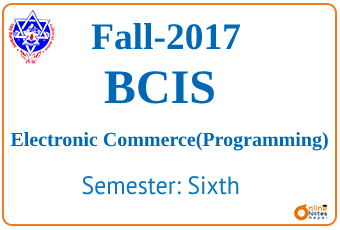Topics


Fall 2017 Electronic Commerce Question
For: Class 6
Published By: Mandra Gurung
Published On: 2021-06-27

Electronic Commerce(Programming)
This is the question set of Electronic Commerce(Programming)Fall 2017, which was taken by the Pokhara University. Pokhara University – Electronic Commerce(Programming) Fall 2017
| Level: Bachelor | Semester –sixth | Year: 2017-Fall |
| Program: BCIS | Full Marks: 100 | |
| Course: Electronic Commerce(Programming) | Pass Marks: 45 | |
| Time: 3hrs. | ||
Section “A”
Very Short Answer Questions
Attempt all the questions.
1. Write is E-Commerce.
2. What are the eight key components of an effective business model?
3. Write about TCP/IP.
4. Define Java and JavaScript.
5. What is Firewall?
6. Define Smart Cards.
7. Explain Data mining.
8. Define Direct email marketing.
9. What is Electronic Data Interchange(EDI)?
10. Define copyright law.
Section “B”
Descriptive Answer Questions
Attempt any six questions 6×10
11. Identify and describe the unique features of e-commerce.
12. Describe the major B2C business models.
13. Explain the features of the Internet and new web(2.0) services.
14. Identify and describe the key security threats in the e-commerce environment.
15. Describe the major types of the e-commerce payment systems.
16. Identify and explain the main types of B2B commerce.
17. Write short notes (any two)
a. Online Marketing Communication
b. Basic ethical Concepts.
c. System Development Life Cycle(SDLC).
18. Section”C”
Case Analysis
Michael Jordan, Director of e-business, Sony “To achieve economies of scale in terms of development time and software costs, we needed a single Web application server. Maintaining separate Microsoft and IBM platforms would not be a cost-effective strategy. More than 70% of Parcel house business is generated from European customers across 13 countries. As an internationally growing business Parcel house focuses on increasing market confidence for its reliable 24 x 7 logistics information management. From DVD players and High Definition Televisions to air conditioning compressors and custom lithionion batteries, the Sony name can be found on hundreds of thousands of customers, businesses, and industrial products. Sony’s diverse product range is a sign of success for the 6500-employees U.S Based in Secaucus, New Jersey, Sony previously supported its 20,000 dealers with B2B e-commerce Web sites built on IBM Web Sphere Application Server. Three sites, one for each business sector, were integrated with Sony’s SAP systems and other legacy applications, enabling dealers to log on to the Web and easily determine the status of their order or the availability of a product. Every online status checks saved. At the same time, the company created B2C online stores for its employees, and for employees of large companies that are valued partners of Sony. These sites, developed with Microsoft Commerce Server and IIS, were not integrated with Sony’s backend systems. Consequently, the company’s call centers were overwhelmed with B2C order-status inquiries. “We couldn’t integrate our Microsoft sites with our backend because Microsoft Commerce Server wouldn’t talk to our corporate-standard databases and integration solutions”, says Michael Jordan, director of e-business at Sony. “Also, we wanted fully automated e-commerce functionality for all our sites, which dictated enhancements across the board. To achieve economies of scale in terms of development time and software costs, we needed a single Web application server. Maintaining separate Microsoft and IBM Platforms would not be a cost-effective strategy.”
Question:
a) What are the objectives that Sony Company wants to achieve by energizing E-Commerce with the help of IBM?
b) How the sales of the Sony products could be enhanced through the E-Commerce Strategy?
c) How to maintain the worldwide marketing customers with the service?